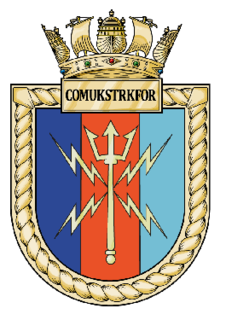
The Royal Australian Navy (RAN) is the naval branch of the Australian Defence Force. Following the Federation of Australia in 1901, the ships and resources of the separate colonial navies were integrated into a national force, called the Commonwealth Naval Forces. Originally intended for local defence, the navy was granted the title of "Royal Australian Navy" in 1911, and became increasingly responsible for defence of the region.

The Australian Defence Force (ADF) is the military organisation responsible for the defence of Australia and its national interests. It consists of the Royal Australian Navy (RAN), Australian Army, Royal Australian Air Force (RAAF) and several "tri-service" units. The ADF has a strength of just over 85,000 full-time personnel and active reservists and is supported by the Department of Defence and several other civilian agencies.

The post of Controller of the Navy was originally created in 1859 when the Surveyor of the Navy's title changed to Controller of the Navy. In 1869 the controller's office was abolished and his duties were assumed by that of the Third Naval Lord whose title then changed to Third Naval Lord and Controller of the Navy. In 1904 his title was changed again to Third Sea Lord and Controller of the Navy. In 1965 the office of the Third Sea Lord was abolished. The post holder is responsible for procurement and matériel in the British Royal Navy.

The Norwegian Armed Forces is the military organisation responsible for the defence of Norway. It consists of four branches, the Norwegian Army, the Royal Norwegian Navy, which includes the Coast Guard, the Royal Norwegian Air Force, and the Home Guard, as well as several joint departments.

The United Kingdom's Strategic Command, previously known as Joint Forces Command (JFC), manages allocated joint capabilities from the three armed services.

Commander United Kingdom Strike Force(COMUKSTRKFOR or CSF) and Rear Admiral Surface Ships (RASS) is a senior post in the Royal Navy.
The Force Element Groups (FEGs) of the Australian Defence Force are the operational capabilities.

The Nigerian Navy (NN) is a branch of the Nigerian Armed Forces. It is among the largest navies on the African continent, consisting of several thousand personnel, including those of the Coast Guard.

Defence Equipment and Support (DE&S) is a trading entity and joint-defence organisation within the UK Ministry of Defence. It began operating on 2 April 2007, following the merger of the MoD's Defence Procurement Agency and the Defence Logistics Organisation, under the Chief Executive Officer of Defence Equipment and Support.
The Australian Defence Organisation (ADO) is composed of the armed forces of the Commonwealth of Australia, the Australian Defence Force (ADF), and the Australian Public Service government department, the Department of Defence which is composed of a range of civilian support organisations.
The Australian Defence Organisation (ADO) is composed of the armed forces of the Commonwealth of Australia, the Australian Defence Force (ADF), and the Australian Public Service government department, the Department of Defence which is composed of a range of civilian support organisations.
Fleet Command is responsible for the command, operations, readiness, training and force generation of all ships, submarines, aircraft squadrons, diving teams, and shore establishments of the Royal Australian Navy. Fleet Command is headquartered at HMAS Kuttabul in Sydney, and is led by the Commander Australian Fleet (COMAUSFLT), also referred to as Fleet Commander Australia (FCAUST), which is a rear admiral (two-star) appointment.

Navy Command is the current headquarters body of the Royal Navy, and its major organisational grouping. It is a hybrid, neither a command, nor simply an installation. Royal Navy official writings describe Navy Command Headquarters both as a physical site, on Whale Island, a collective formed of the most senior RN officers, and as a budgetary grouping.

Rear Admiral Stephen Richard Gilmore, is a retired senior officer of the Royal Australian Navy. He served as Commander Australian Fleet from October 2009 until December 2011, and as the Head Australian Defence Staff (Washington) and Australian Defence Attaché at the Embassy of Australia, Washington, D.C. from January 2014 until his retirement in 2017.
The Information Warfare Directorate of the Royal Australian Air Force's Air Warfare Centre (AWC) is the Australian Defence Force's central institution dealing with tactical information warfare.

The Assistant Chief of the Naval Staff (A.C.N.S.) is a senior appointment in the Royal Navy usually a two-star rank and has a NATO ranking code of OF-7.

The Assistant Chief of Naval Staff formerly the Assistant Chief of the Naval Staff is a senior Royal Navy appointment responsible for naval aviation. The post is also the successor to the Royal Navy's Flag Officer for naval aviation in the British Isles, established since 1939.
The Chief of Joint Capabilities (CJC) is the head of the Joint Capabilities Group (JCG) in the Australian Department of Defence, part of the Australian Defence Organisation. This position was created on 1 July 2017. The current chief is Vice Admiral Jonathan Mead, who was appointed to the position on 24 November 2020.
At the end of the Cold War in 1989, the Royal Navy structure was as follows:
Vice Admiral Jonathan Dallas Mead, is a senior officer in the Royal Australian Navy. He joined the navy via the Royal Australian Naval College at HMAS Creswell in 1984, and spent his early career with the Clearance Diving Branch before training as a Principal Warfare Officer. He captained HMAS Parramatta on operations in the Persian Gulf from 2006 to 2007 during the Iraq War and commanded Combined Task Force 150, overseeing maritime counter-terrorism operations around the Arabian Peninsula and Horn of Africa, from 2011 to 2012. He served as Head of Navy Capability from 2015 to 2017, Commander Australian Fleet from 2018 to 2020, and was appointed Chief of Joint Capabilities in November 2020.








